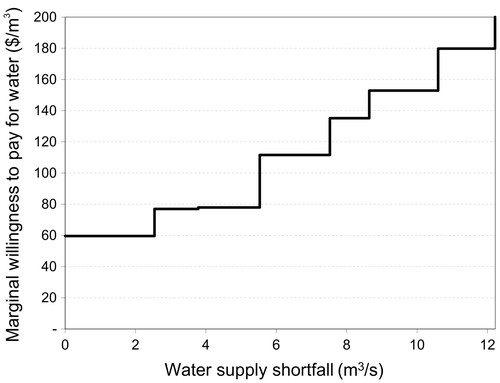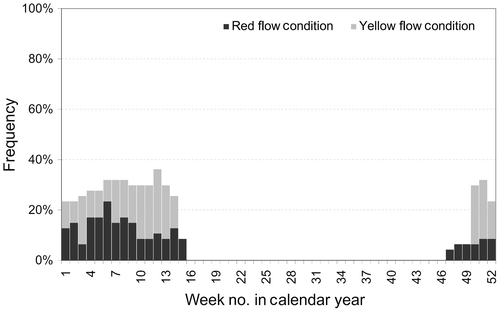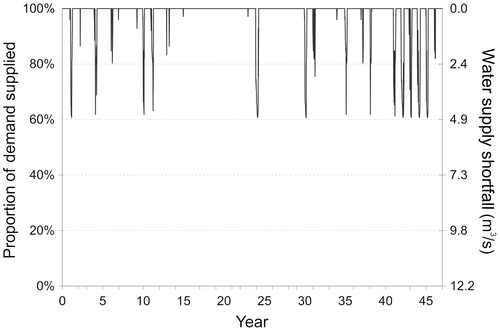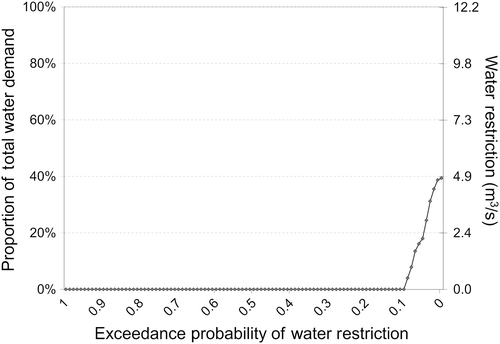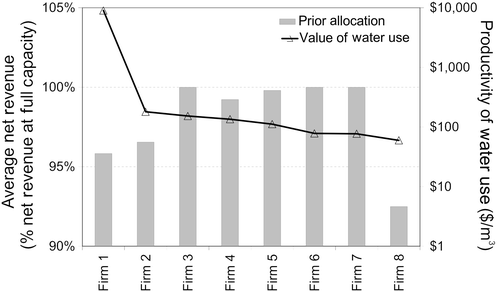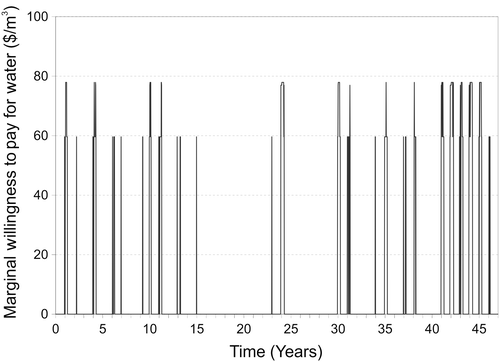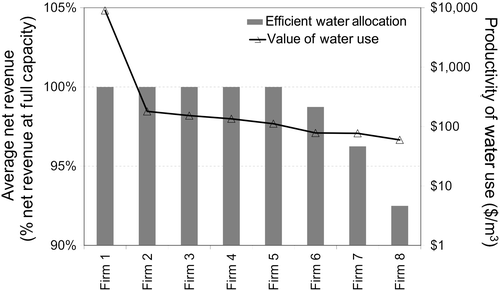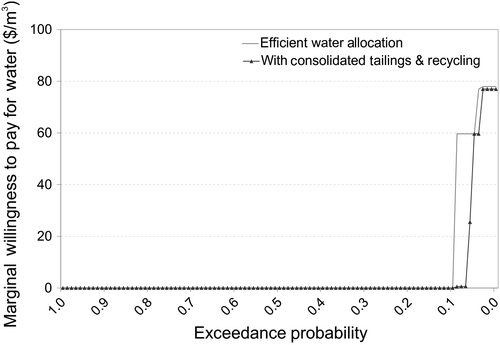Abstract
Limits on water diversions from the Athabasca River may affect the growing oil sands industry in the medium term. For new entrants, the costs of future water restrictions may be high due to the combination of a strict water conservation regulation, a profitable oil sector that relies on fresh water, and water allocation in order of licence seniority. Though river flows would, for the most part, be preserved and well within 90% of the flows recorded upstream of industry, the future value of water for oil production is estimated to be up to $80 per cubic metre in a single period (peak spot value, approx.), and $72,000 per megalitre if drawn annually as an ongoing, continuous demand (average marginal value in present terms). These results are based on certain model assumptions, including flows that are 10% less than the historic record, a simplified depiction of the production costs and revenues of oil producers, and no access to technologies that may reduce the cost of water restrictions. Using a medium-term (~2020) static demand scenario, a policy and two technologies to reduce the costs of water restrictions are assessed. A combined policy-technology response was found to be the most cost effective. As various technologies that lower costs are already planned or in use, further consideration of an efficient water allocation policy, such as water charges, that may reduce costs by providing incentives for efficiency and technology investment across all firms – not just new entrants – is recommended. In general, the results of this study indicate the importance of designing regulations that encourage conservation goals to be achieved at least cost. Future studies may consider the water diversion limits in the Athabasca River, including whether the costs of conservation are commensurate with the economic value of in-stream flows.
À moyen terme, des contraintes sur l’utilisation de l’eau de la Rivière Athabasca pourraient ralentir l’essor de l’industrie du pétrole des sables bitumeux. Pour les nouveaux entrants, les coûts de restrictions d’eau futures peuvent être élevés en raison de la combinaison d’une politique stricte sur la conservation de l’eau, un secteur pétrolier rentable qui dépend de l’eau, et la répartition de l’eau par ordre de séniorité des licences. Bien que le flux de la rivière serait, pour la plupart, préservées et bien en deçà de 90% des niveaux de flux historiques en amont de l’industrie, nous estimons la valeur future de l’eau par période a 80$ par mètre cube (valeur au comptant en période de pointe, approx.), et 72 000$ par million de litres si elle est puisée chaque année comme une demande continue (valeur marginale présente moyenne). Ces résultats sont basés sur des hypothèses du modèle, comme des flux en deçà de 10% des flux historiques, une représentation simplifiée des coûts de productions et des revenues des producteurs de pétrole, et l’absence d’accès a des technologies qui pourraient réduire les coûts de restrictions d’eau. A l’aide d’un scénario de demande statique à moyen terme (~2020), nous évaluons une politique alternative et deux technologies pour réduire les coûts de restrictions d’eau. Une solution mixte politique-technologie a été jugée la plus rentable. Comme diverses technologies pour réduire les coûts sont déjà prévues ou en cours d’utilisation, nous recommandons un examen plus approfondi d’une politique qui encourage une allocation efficace de l’eau, comme des redevances sur l’eau, qui pourrait réduire les coûts en incitant toutes les firmes – pas uniquement les nouveaux entrants – à l’efficacité et a l’investissement en technologie. En générale, nos résultats soulignent l’importance d’établir des règles qui encouragent à atteindre les objectifs de conservation au moindre coût. De futures études pourraient prendre en compte les limites de diversion d’eau de la Rivière Athabasca, et voir si les coûts de conservation et la valeur économique des flux sont commensurables.
Introduction
To produce oil from the Athabasca oil sands deposit in Alberta, Canada, requires water – preferably fresh (Rogers Citation2006). To minimize ecological impacts, Phase I of the water management framework for the lower Athabasca River sets limits on surface water use by industry (Alberta Environment and Fisheries and Oceans Canada Citation2007). The specified limits are well above recent water use, and restrictions are unlikely to take effect in the short term (Mannix et al. Citation2010).
The water conservation regulation affects the investment outlook of the growing oil sands sector. Water allocation is based on licence seniority, akin to ordered, grandfathered entitlements (i.e. “first-in-time first-in-right”). New oil sands developments are at risk of water restriction, whereas the longest running operations have a secure supply. Permanent water trade is presently unavailable in the Athabasca River basin though annual water assignments are possible between licensees subject to conditions (Alberta Water Act 1996, s. 33). The water conservation regulation requires the current operators to agree on annual contingency plans to assign water; to date these essentially confirm the default state that water will be allocated in order of seniority (e.g. Oil Sands Developers Group Citation2013). Risk management for new entrants is thus limited in practice to on-site efforts to reduce and alter the timing of their fresh water demands.
Given the economic importance of the oil sands sector (e.g. Honarvar et al. Citation2011), an implementation plan to address the future risk of water restrictions is prudent to minimize the costs to industry and the Canadian economy. From an economic efficiency perspective, an inclusive, long-term plan that is open to prospective new entrants is likely to be preferable to the present approach of an annual planning outlook and consensus among exclusive stakeholders. Aside from financial benefits, by minimizing impacts to a subset of key stakeholders (industry), a least-cost approach would presumably contribute to the ongoing acceptance and political stability of the environmental regulation.
This paper presents an assessment of alternatives to reduce the future costs of the water-use limits in effect for the lower Athabasca River. A stylized, generally specified policy that produces an efficient water allocation, and two technology alternatives, (1) off-stream storage and (2) consolidated tailings and water recycling, are assessed along with combinations thereof. The assessment is relative to the present method of water allocation. Based on a static future water demand (~2020), the future costs of water restrictions to new industry appear to be high, though they can be reduced by a blend of policy and technologies.
Background
Water allocation
Water is allocated in Alberta in order of licence seniority under a government-administered system known as prior allocation (Percy Citation2004). Seniority is denoted by the date of acceptance of a licence application. When water is scarce, this system allows holders of senior licences to obtain their entire licensed volume (to the extent of the available supply) while junior licensees go without. There are no volumetric charges for water use.
An environmental impact assessment of an oil sands facility must be approved for a water licence to be issued for industrial (processing) purposes. The licences specify a maximum instantaneous rate of river diversion and annual rates of diversion. Licences are subject to review and may be modified “to ensure the most beneficial use of the water in the public interest” (e.g. Alberta Environment Citation1987, 3). The licences have custom conditions including variations in water-use limits over different phases of the facility lifecycle (more is required for start-up operations), and specification of a variety of water sources (e.g. the Athabasca River, its tributaries and groundwater). A further, unlicensed source is contaminated water held in tailings ponds under a zero-discharge regulation. Compared to alternatives, water from the Athabasca River is generally preferred by industry for its high-quality, reliable supply (Rogers Citation2006).
Water availability
Unlike in adjacent basins that have large on-stream dams, the flow in the Athabasca River has a natural pattern. Taking water from the river has a greater ecological impact when flows are at their lowest during winter (Phase 2 Framework Committee Citation2010). The volume taken and the timing of abstraction must comply with the minimum in-stream flow allowances of the Lower Athabasca Water Management Framework (Table ). The available water supply to industry varies on a weekly basis depending on the rate of in-stream flow compared to the historic record (Alberta Environment and Fisheries and Oceans Canada Citation2007).
Table 1. Water conservation regulation for the lower Athabasca RiverTable Footnotea.
The combination of an in-stream flow allowance and demand for fresh water sets up the conditions for water scarcity. Demand is not yet sufficient for the water-use limits to be binding. The amount of water taken from the river in 2011 was 3.6 m3/s, which is equivalent to approximately 2% of the average flow rate in February, the month of lowest flow. The 2011 rate of water use is less than half the estimated demand threshold of 7.5 m3/s (approx.) required for water restrictions to take effect (Mannix et al. Citation2010).
Demand characteristics
Water diversions from the Athabasca River are mostly for surface-mining and processing purposes rather than in-situ mining. As described by Rogers (Citation2006), water is used for various purposes, and large quantities are recycled by the preferential use of separate streams of varying quality and quantity. Fresh water from the Athabasca River is used as an input to run an operation’s on-site utilities. Water discharge from utilities is saline and may be re-used as process water for extracting bitumen from the mined oil sands. Contaminated water from the bitumen extraction process is disposed of into tailings ponds. Water is also used to create a wind buffer (freeboard) to prevent re-entrainment of settled tailings in ponds, along with other sundry needs (e.g. drinking water, fire suppression, road dust containment, etc.). Water demands are fairly steady throughout the year (Rogers Citation2006).
Price elasticities of water demand for the oil sands sector either have not been studied or are not publically available. In the short run, demand may be particularly inelastic. If the water supply from the Athabasca River were to cease at short notice, Syncrude has estimated that short-run conservation measures may allow a few days of continued operation, with shutdown able to be avoided by 30 days (approx.) using the free water inventory of tailings ponds (Matte Citation2004). New operations may be unable to generate this level of free water inventory.
The unique process of oil production from oil sands suggests that technology development may have a strong influence on the long-run demand for water. Breakthrough technology that may produce large reductions in water use may be particularly important. Potential technologies in this realm include dry tailings technology for surface-mining operations (BGC Engineering Inc. Citation2010), and toe-to-heel air injection for in-situ mining (Petrobank Energy and Resources Ltd. Citation2014).
Recent studies
There is a concentration of information on the physical impacts of water use by the oil sands sector (e.g. Gosselin et al. Citation2010; Phase 2 Framework Committee Citation2010), yet there are few studies that consider the issue from an economic perspective. Adamowicz (Citation2007) presents a preliminary discussion of policy and technology alternatives. Among these alternatives, Kim et al. (Citation2013) provide a recommendation for tradeable water rights and water charges based on a limited multi-criteria assessment. Gaudet et al. (Citation2006) consider the optimum trade-off between oil and agricultural demands in Alberta, though the problem is not relevant to the Athabasca River basin where agriculture comprises only 1% of licensed water diversions (Alberta Environment Citation2007).
Method
In this study, the costs to industry of the water conservation regulation under the prior allocation system, and the cost savings from the introduction of selected policy and technology options using available information on industry costs and revenues, are estimated as outlined below. Although the use of economic models to predict water policy outcomes is common (He and Horbulyk Citation2010; Booker et al. Citation2012), the authors are unaware of previous published studies applied to water management of the Canadian oil sands sector. The method and major assumptions are described below. Refer to Mannix (Citation2009) for a complete outline. The selected options were:
A stylized policy, referred to as efficient water allocation, that yields a maximum return from oil production for a given water supply.
Off-stream storage to avoid interruptions in the water supply.
Recovery of water stored in mature-fine tailings, known as consolidated tailings technology, with increased water recycling to reduce freshwater demands.
Combinations of efficient water allocation and one of storage or consolidated tailings.
These alternatives were assessed relative to a base case of water allocation by licence seniority, referred to as prior allocation. The results are presented in net present values calculated over 20 years at a discount rate of 8% (Jenkins and Kuo Citation2007; Treasury Board of Canada Secretariat Citation2007), measured in Canadian dollars equivalent to 2007 price levels.
Water supply and demand
The accessible water supply was calculated using a weekly time series of in-stream flow and the Phase I rules of the Lower Athabasca Water Management Framework (Table ). Flows were estimated at background levels below Fort McMurray, spanning 47 years (data supplied by the Alberta Government). Flows were decreased by 10% to account for the original data period, 1958 to 2005, coinciding with a wet climatic cycle (e.g. Case and McDonald 2003). The available supply in each week was calculated in a spreadsheet model described by Mannix et al. (Citation2010).
A medium-term, constant industrial water demand of 12.2 m3/s and oil production of 441,000 m3/d were assumed (Table ). The demand scenario assumes the full utilization of water licences issued by 2008 combined with a medium-term oil production forecast to 2018 (Dunbar Citation2008). The scenario is well above the present water use, though it is within the present licensed rate of 13.5 m3/s (average, surface water sources, 2012). The water demand scenario is labeled with a cursory, indicative year of 2020.
Table 2. Licensed water-use, seniority rank of licences and modelled forecast water demand by year 2020 (approx.) by oil sands firm.
As profiles of water demand for individual firms are not available, a range of assumptions are made to estimate costs and water allocations. Except in the use of consolidated tailings technology, it is assumed that there are no substitutes for water diversion from the Athabasca River. Facilities operate at full capacity at all times except when the river water supply is restricted. All firms are assumed to receive revenues of $440 per m3 of oil production, or $70 per barrel. When water restrictions take effect, oil production drops instantaneously by the percentage of restriction below licensed water use. Production and cost functions for each firm are assumed to be linear (i.e. the marginal water use (operating cost) equals the average water use (operating cost) per unit of oil produced). Given an absence of publicly accessible information, uniform operating costs of $166 per m3 or $26.46 per barrel are assumed (Syncrude Canada Ltd. Citation2007). Thus, all firms receive a net revenue of $274 per m3 of oil production or $43.50 per barrel. While these cost and revenue estimates are based on available information (and will not be as accurate as private estimates by individual firms), and the production technologies assumed are relatively simplistic, these measures provide insights into the efficiency of the policy and technology options. The absolute levels of cost savings will depend on these assumptions and, thus, a sensitivity analysis is conducted to examine the impact of these assumptions. Individual firms are distinguished by their productivity of water use derived from the data in Table . The series of water-use productivity by firm was used to construct a demand profile for water (Figure ).
Prior allocation
The current system of prior allocation is used as the base case from which the cost savings of the policy and technology options are calculated.
The water allocated to each firm in each week of the analysis is calculated based on water availability, water demand and the seniority of the water licences held by the firm (Table ).
Efficient water allocation
The cost savings from efficient water allocation were modelled based on a stylized policy. This could take the form of economic instruments such as water trade within a perfectly competitive market, or a pricing mechanism that allocates water to the most efficient operations. Potential market imperfections or other losses were not considered.
An efficient water allocation to each mining operation was calculated for each week by solving the following linear programming problem: (1)
Subject to:
Total water availability constraint;(2)
Average diversion constraint across licences;(3)
Instantaneous diversion constraint across licences;(4)
Production design limit of mining operation;(5)
where:
| t | = | Time, in weeks, where t = 1,...,2444, covering the period of stream flow; |
| a | = | Revenue minus variable cost per unit of oil production ($/m3); |
| i=1,… n | = | Set of individual licences; |
| j=1,…,m | = | Set of individual mining operations (company and/or project); |
| bi,j | = | Binary matrix (n x m), where bi,j is equal to one (1) when licence, i, corresponds to mining operation, j, otherwise zero (0); |
| ej | = | Water-use productivity (m3 of oil produced per m3 of water use) of individual mining operation, j, estimated as a fixed rate equal to: |
| wi,t | = | Water allocated (m3/s) to individual licence, i, in week t; |
| Wt | = | Total water available for extraction (m3/s) in week t according to the water conservation regulation; |
| Qmean,i | = | Average water diversion (m3/s) allowed under individual licence, i, calculated based on the annual licensed water-use (Table ); |
| Qmax,i | = | Maximum instantaneous water diversion (m3/s) allowed under individual licence, i; |
| Ymax,j | = | Oil production capacity (m3/s) for individual mining operation, j. |
The average diversion constraint (Equation 3) for calculating the model on a weekly time-step is stricter than the annual licence conditions that apply in practice. As production in each week is assumed to be maximized to the extent of the available water supply, and up to the production design limits of each firm, this weekly formulation produces equivalent results to that of an annual constraint.
A net present value is calculated from the average net revenue across all firms under efficient water allocation (Equation 1), measured relative to the average net revenue across all firms under prior allocation, applied in each period of the 20-year calculation.
Consolidated tailings
Published information on technologies to increase the productivity of water use by the oil sands sector rarely includes cost estimates. Consolidated tailings technology is an established technology for which information is available. (A regulation on stored water in tailings was introduced after the research was conducted (Directive 074 – Tailings Performance Criteria and Requirements for Oil Sands Mining Schemes) and at the time of publication had not been fully implemented. The technology development underway to meet this regulation would impact water demands, and in particular the relevance, and cost, of the technology option of consolidated tailings and increased recycling. The results of this option should thus be viewed as an example technology option in terms of its impact on water supply and demand).
An example of an on-site water balance for an oil sands surface mine (Allen Citation2008) was manipulated to estimate the capacity of water recycling and the impact on water demand. It is assumed that consolidated tailings and increased water recycling are used intermittently to substitute for a lack of supply from the Athabasca River, as follows:
Consolidated tailings technology is used to recover water that would otherwise be disposed to tailings ponds without further use.
Recovered water from tailings is used for bitumen extraction, providing a substitute for water that would otherwise be supplied by saline wastewater discharge from on-site utilities.
Wastewater discharge from on-site utilities is desalinated and recycled to run utilities, providing a substitute for water that would otherwise be supplied from the Athabasca River.
Consolidated tailings technology has the potential to recover up to 73% of the water held within tailings (MacKinnon et al. Citation2000). To recycle water to supply on-site utilities, the use of reverse osmosis technology that operates 85% of the time and achieves an 80% recovery of desalinated water is assumed (RosTek Associates et al. Citation2003).
The capacity of consolidated tailings and desalination technology is estimated, rounded to the nearest 10% of full implementation, that would maximize the net present value for each surface mine given its outlook for water supply from the Athabasca River (i.e. the average water supply under prior allocation, or, under a combined policy-technology scenario, the average water supply under efficient water allocation). A simplified analysis that considers the operation costs for consolidated tailings, and the capital and operation costs of wastewater desalination, is used. To consolidate tailings, for each cubic metre of fluid tailings a dose of 1 kg of gypsum is assumed (Matthews et al. Citation2000) at a cost of $0.11 (Heemskirk Canada, pers. comm.). Capital and operation costs of reverse osmosis were interpolated from an industry guide (Rostek Associates et al. Citation2003). Other costs such as brine disposal, greenhouse gas emissions and impacts on bitumen extraction are not considered, nor are other benefits such as those in relation to reduced storage of liquid tailings.
A net present value is calculated assuming that construction of the technology, where worthwhile for each firm, starts in the first period. Once the technology is operational, benefits are calculated from the sum of the average net revenue for each firm, given an ability to invest in consolidated tailings technology to mitigate water supply shortfalls, measured relative to the sum of the average net revenue under prior allocation. Costs are subtracted in the periods in which they are incurred.
Storage
A single off-stream storage capable of eliminating the likelihood of water restriction is considered. The storage is filled from the Athabasca River during weeks of surplus, and water is released downstream when the available water supply is scarce. Excluding net evaporation and seepage, a simple water balance is used to calculate the required storage capacity as follows:(6)
Subject to:
Balance of stored water;(7)
Boundary conditions;(8)
Initial condition;(9)
where:
| C | = | Storage capacity, in gigalitres (GL); |
| t | = | Time, in weeks, where t = 1, ..., 2444; |
| St | = | Storage at time, t, in GL; |
| Wt | = | Total water available for extraction (m3/s) in week t; |
| i=1,…,n | = | Set of individual licences; |
| Qmean,i | = | Average water diversion (m3/s) allowed under individual licence, i, calculated based on the annual maximum licensed water-use. |
The costs of dam construction and operation were based on a conceptual study of storage options (Golder Associates Citation2004). That study identified locations where a single, shared storage would be significantly cheaper than private, on-site options to supplement the water supply. Variable components of the original cost estimates for an 80 GL storage were interpolated to reflect the modelled capacity (C). A three-year duration was assumed for storage design and construction. Preliminary calculations (limited by the coarse nature of the cost estimates) indicate that the marginal cost of water restriction would be greater than the marginal cost of increasing the storage capacity up to a level that avoids restriction; thus, no additional optimization was performed.
A net present value is calculated assuming that construction starts in the first period. Once the storage is operational, benefits are calculated from the net revenue at full production across industry, measured relative to the sum of the average net revenue for each firm under prior allocation. The costs of storage are subtracted in the periods in which they are incurred.
Sensitivity analysis
The sensitivity of results was tested by altering the water supply and the price of oil (Table ). Other sensitivity analyses performed, though not presented in this paper, include the degree of water conservation, rate of water demand, demand profile and sequence of technology implementation.
Table 3. Parameters tested by sensitivity analysis (applied to all options).
Results
Water restrictions
Based on the assumptions of this analysis, it was found that water restrictions would occur approximately 10% of the time, and would only take effect in the winter, low-flow months of the year (Figures to ). The severity of water restrictions was up to 40% of the total water demand. The average water restriction equates to 0.3 m3/s or 8.2 GL per year, and is equivalent to 2% of the total water demand. These results apply to the prior allocation and efficient water allocation options that do not impact the total water supply or demand across industry.
Prior allocation
Without policy or technology measures in place, water restrictions under prior allocation create costs to industry equivalent to 1.8% of annual net revenues of the sector, or $790 million per year (on average) in lost production when compared to a case of no restrictions. This impact is unevenly spread toward new entrants that use modern technologies and those with a higher productivity of water use. For example, a new firm with superior productivity of water use from the Athabasca River (a steam-assisted gravity drainage [SAG-D] facility) is estimated to lose 4.2% of annual net revenue due to water restrictions, whereas five of the eight firms with mid-range productivities are subject to losses of less than 1% (Figure ). The marginal willingness to pay for water among firms facing water restriction is estimated to be as high as $180 per m3 (this estimate excludes the SAG-D facility).
Efficient water allocation
If a policy is implemented that results in an efficient allocation of water, the marginal willingness to pay for water is up to $78 per m3 (Figures and ). This amount per volume (m3) would apply over a weekly time-step when restrictions take effect. The average marginal value of water across all periods is $6.70 per m3; an equivalent measure in present value terms (indicative of the value of a permanent water transfer) is $72,000 per ML. Under this policy, water is preferentially allocated to the firms with the highest productivity of water use (Figure ), creating a present benefit of $2.9 billion.
Consolidated tailings
Consolidated tailings and increased recycling together provide a limited substitute for water supplied from the Athabasca River. The technology is worthwhile for four of the seven surface-mining operations, allowing freshwater demands to be reduced by up to 2 m3/s. The technology’s optimum capacity is at times below the rate of water restriction, and so there are continued impacts on the water supply at a lower frequency and severity than if the technology were not in use (Figure ). The technology has the effect of reducing the average water supply shortfall by 46% or 3.7 GL per year, to a total average shortfall of 4.6 GL per year.
Figure 9. Likelihood and magnitude of supply shortfall (~year 2020) with use of consolidated tailings and increased recycling, as compared to prior allocation.
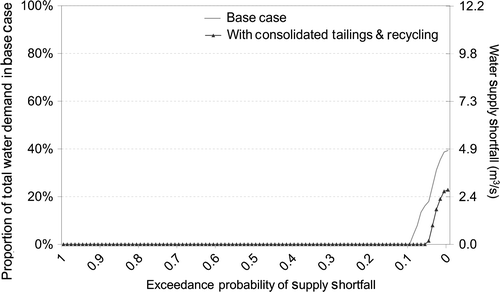
The technology produces a shift in the demand profile for water from the Athabasca River (Figure ). Average variable costs of water treatment are an estimated $0.55 per m3 of substituted supply. The average capital and operation costs per m3 of annual avoided river diversion are $6.20; this is equivalent to a present value of $67,000 per ML.
Figure 10. Marginal willingness to pay by oil sands industry for water supplied from the Athabasca River (~year 2020) with use of consolidated tailings and increased recycling, as compared to efficient water allocation.
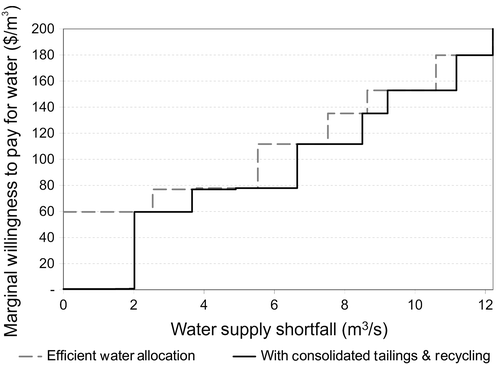
The present value of the capital and operation costs of the technology is an estimated $250 million. The technology is estimated to avoid costs of approx. $3.0 billion by reducing the demand for fresh water and, in turn, the impact of water restrictions on production, resulting in a net present value of $2.7 billion.
If water allocation is administered under an efficient policy rather than prior allocation, consolidated tailings and increased water recycling is worthwhile for three of the seven surface-mining operations. The technology’s optimum capacity is similar to before (within 0.05 m3/s). The net present value attributable to the technology is substantially less at $1.9 billion; this is due to the lower productivity of water use among the firms subject to a reduced supply of fresh water. The combination of an efficient water allocation policy and consolidated tailings technology has a much higher net present value than if either option were implemented alone, at $4.8 billion. Assuming the policy is implemented beforehand, the combined option lowers the marginal value of water from the Athabasca River to an average of $4.15 per m3 across all periods (Figure ); this is equivalent to a present value of $45,000 per ML.
Storage
A storage capacity of 45 GL is required to avoid water restrictions under the 12.22 m3/s demand scenario. Based on a capital cost of $45 million and operation costs of $1.6 million per year, this option avoids costs of $6.4 billion due to water restrictions. The average cost per m3 of annual avoided river diversion is $0.60; this is equivalent to a present value of $6500 per ML. This option has a net present value of $6.3 billion.
The net present value of storage is maximized when combined with efficient water allocation ($7.1 billion). This is because efficient water allocation reduces the costs of water restrictions in the period during dam construction and commissioning. In this case, the incremental benefit of storage is $4.2 billion (present value).
The value of storage decreases, though remains worthwhile, when consolidated tailings and increased recycling has previously been implemented. In this case, the incremental net benefit of storage is $3.6 billion (present value).
Summary of results
All options analyzed were found to reduce the costs of water restrictions (Table , Figure ). Storage is the most cost effective as it can be designed to a sufficient capacity to eliminate impacts on oil production. The technology options have a greater value when combined with an efficient water allocation policy. These combined options lower the impacts on production by reducing the exposure to water restrictions and reallocating water when shortfalls remain (Figure ). Even if storage is the preferred option, efficient water allocation may be beneficial during the design and construction phase when the technology is not yet in use. Efficient water allocation and storage is a superior combination that maximizes net present value ($7.1 billion).
Table 4. Net present value of policy and technology options, $ million.
Figure 12. Net present values of policy and technology options compared to base case of prior allocation, $ million.
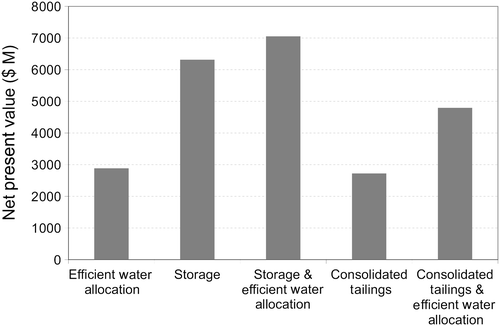
Figure 13. Distribution of firm revenue as a proportion of full production, comparison of prior allocation and efficient water allocation. Firm productivity of water use from Athabasca River shown on the secondary axis (log scale).
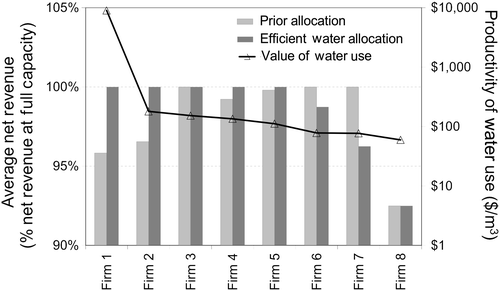
To put the results into context, the annual net revenue of industry under the assumptions of this study (~ year 2020) is $44 billion per year. The estimated costs of storage are equivalent to 0.1% of the annual net revenue, and the benefits of storage are equivalent to 1.8% of net revenues in each year of storage operation. While the benefit appears small, the impact is not insignificant for new entrants. The latest entrant with the most junior water licence is expected to regain 7.5% of net revenue by relying on stored water, while the next in order is expected to regain 4.2% of net revenue from storage and/or efficient water allocation.
Sensitivity of results
Sensitivity analyses of climate change and oil price confirmed the finding that storage is a preferred solution that reduces the costs of water restrictions, particularly when combined with efficient water allocation (Table ). The benefits of storage are somewhat reduced if some facilities are already using consolidated tailings technology. The results of further sensitivity analyses of water conservation scenarios, demand rates and demand profiles are available from the authors.
Table 5. Sensitivity analysis of policy and technology options, $ million.
Discussion
This study examines the cost effectiveness of a policy and two technologies to reduce the future costs of water restriction to oil sands industry along the lower Athabasca River. As there is minimal risk of the water restriction rules taking effect at present, a medium-term (~2020) scenario is used to illustrate the potential costs and cost savings.
Though water restrictions are not likely to take effect in the short term, the analysis is relevant today due to the long-term nature of investments in oil production and the custom technology needs of the oil sands sector. The costs to adapt to water scarcity are revealed in part by the water storage plans for new mines. The most recent development, Imperial Oil’s Kearl project, is designed to operate over 40 years with plans to store a 30-day supply of fresh water to mitigate future risks (Imperial Oil Citation2013a, Citation2013b). The Canadian Natural Resources Ltd. Horizon mining operation provides a similar example with a storage design of 2 GL (AECOM Citation2009) or at least 2 weeks’ demand. Investment in water recycling by existing facilities may also relate to the risk of future water scarcity. Syncrude, one of the longest running surface-mining operations, recycles process water at a rate of above six times the net annual volume withdrawn from the Athabasca River (Syncrude Canada Ltd. Citation2014). Further, the subject aligns with an intention to prevent barriers to new entrants via efficient regulation (Alberta Competitiveness Act 2010).
The results of this study indicate that under certain conditions and model assumptions, the implied (or shadow) value of water may be very high when the water restriction rules take effect. Introducing a policy that encourages water to be supplied to the firms with the highest productivity of water use can lower the costs of water restrictions across industry. Even so, a peak (spot) value of water of approximately $80 per m3 and an average marginal value of $ 72,000 per ML is estimated. These values are based on a certain set of assumptions, including flows that are 10% less than the historic record, a simplified depiction of the production costs and revenues of oil producers, and no access to technologies that may reduce the cost of water restrictions. However, even if these values were found to be lower by an order of magnitude, the results are still above the peak values of water noted elsewhere. For example, during a prolonged drought in a region within the Murray-Darling Basin, Australia, seasonal prices of water reached a peak of approximately $1 per m3 (Mannix and Adamowicz Citation2011).
The high future value of water in the Athabasca River estimated by this study reflects the remarkable circumstances of a strict water conservation regulation combined with a profitable oil sector that relies on fresh water. The results suggest that abstaining from diversions of up to 0.3% of the annual flow and up to 5% of the instantaneous flow (leaving 97% of the annual flow and at least 89% of the instantaneous flow to remain in-stream) would need to produce environmental benefits worth up to $790 million per year to outweigh the costs of the water restrictions, should no cost reduction measures be taken. These findings indicate the importance of finding solutions to lower implementation costs, and suggest a potential need to reevaluate the water restriction rules in their present form.
The water restriction rules were developed with a focus on detailed ecological information (Alberta Environment and Fisheries and Oceans Canada Citation2007). Since the regulation was introduced, negotiations with stakeholders to refine the rules have focused on an ecosystem base flow that would further restrict the water supply to new industry (Phase 2 Framework Committee Citation2010). In contrast, given the estimated high value of water to industry at times of low water use in proportion to the total flow, the results of this study suggest that there may be benefit in reviewing the water conservation regulation by considering the value of in-stream flows. This would involve estimating the relationship between seasonal water conservation and marginal environmental benefits (e.g. Horne et al. Citation2010). In theory, the standard approach from an economics perspective is to set the level of environmental protection such that the marginal benefits of in-stream flows are consistent with the marginal costs of water restrictions (Field Citation2001). The announcement of the water restriction rules well in advance of when restrictions may take effect is positive as this enables planned adjustments by industry, such as early investment in technologies that reduce and alter the timing of freshwater demands.
Should the water conservation regulation continue, based on this analysis of a static future water demand and production scenario, it was found that the costs of water restrictions are best avoided by constructing storage to avoid restrictions altogether. Dynamic factors such as the timing of when to construct storage, of a certain capacity over time, or the uncertainty of future development, are not examined. The benefits of storage are increased when combined with a policy that efficiently allocates scarce water during the lead-up to storage completion.
New developments are building their own dams to protect against water restrictions rather than waiting for shared solutions. The results of this study suggest that a policy that produces an efficient water allocation is potentially a solution that reduces costs even if dams are under construction. Such a policy would counter the exclusive nature of the prior allocation system that otherwise loads the burden of meeting environmental targets onto new entrants. For example, an efficient water allocation policy may provide ongoing incentives across industry to invest in water-efficient technology development and adoption where economically worthwhile.
In practice, an efficient water allocation policy would take the form of an economic instrument. Price-based instruments may be more suitable than quantity-based instruments due to the local context. Relevant factors include heterogeneous water licences in terms of supply risk and maximum versus average diversion limits, water licences that are tied to land and the purpose of water use, imperfect competition dominated by two firms that hold senior licences, the availability of substitute water sources that are hydrologically connected to the Athabasca River, and the administrative complexity of weekly restriction rules. Options for the design of a price-based instrument include prices that vary according to the flow conditions of the water management framework (Table ), refundable charges (e.g. Sterner and Isaksson Citation2006) and hybrid policies such as charges applied to water use above a set threshold (Pezzey Citation2003). The design of such a policy ought to allow innovative, inexpensive approaches that lower the environmental impacts of water diversions – for example, engineering solutions that sustain fish habitat when river flows are abnormally low.
The results of this applied economics study should be viewed in light of the method adopted. Conservative assumptions include uniform productivity of water use by each firm, and no input substitutes for river water such as private on-site storage. The impact of these is countered by an assumption of operation costs in proportion to the degree of water restriction; in reality, some costs would not vary over the short run. In the likely case that firms exhibit declining marginal productivity of water use, or there is excess licensed water use (contrary to the study assumptions), the benefits of the efficient water allocation policy would be greater than estimated here, and the benefits of the technology options would be less than estimated. Extensive tests of sensitivity confirmed the overall finding that a combined policy-technology approach is most successful at lowering the future costs of water restrictions.
For further study, exploring the design details of an efficient water allocation policy is recommended. As technology may have a strong influence on the long-run demand for water, design elements that incorporate continuing incentives for technology development will be important. Model refinements may include more detailed specification of production costs (Rahnama et al. Citation2008; Plourde Citation2010). A broader topic to consider is the dynamic efficiency of the prior allocation system, including its impact on new investment and the productivity of water use given the lumpy investment profile of the oil sands sector. Lastly, this study has focused on water quantity and the water conservation regulation rather than water quality. Available information does not indicate that the water quality impacts of the oil sands industry are a significant concern (Gosselin et al. Citation2010), though the topic is of continued interest. It is of note that when fresh water is inaccessible, alternative production methods (e.g. vapour extraction process) may use synthetic water substitutes such as solvents that in turn have environmental risks (Speight Citation2013).
Conclusions
Although water is not scarce at present, the water conservation regulation for the Athabasca River is relevant to the medium-term investment outlook for the oil sands sector. This is because fresh water is a key input to production, and the typical project life of surface-mines spans many decades.
The results of this study show that the future costs of water restrictions to oil sands industry under Phase I of the water management framework may be high, particularly for new entrants. When compared to values of water observed elsewhere, the results suggest there may be a need to re-evaluate the water restriction rules to ensure that the costs of conservation are in accordance with the economic value of in-stream flows.
The costs of water restrictions can be reduced by a blend of policy and technologies. Water storage was found to greatly reduce costs and is already being implemented by new operations. To further reduce costs within a policy framework that is inclusive to new entrants, and to encourage increases in water-use productivity across industry where economically worthwhile, consideration of an economic instrument to manage water diversions (e.g. water charges) is recommended. This instrument should be custom-designed to take into account the relevant contextual factors, including the in-stream value of water, market factors and the important influence of technology.
Acknowledgements
The authors thank current and former staff of the Government of Alberta for the provision of water data, including flow, licences and water use. Thanks also to three reviewers for their suggestions that enhanced the quality of this paper.
References
- Adamowicz, W. L. 2007. Water use and Alberta oil sands development – science and solutions: An analysis of options. In Running out of steam? Oil sands development and water use in the Athabasca River-watershed: Science and market-based solutions, 40–58. Edmonton, AB: University of Alberta Environmental and Research Studies Centre and University of Toronto Munk Centre for International Studies.
- AECOM. 2009. Horizon Oils Sands project – water supply and water system. http://www.uma.aecom.com/MarketsAndServices/46/08/index.html (accessed July, 2009).
- Alberta Environment. 1987. Licence to divert and use water. Pursuant to the Water Resources Act. Suncor Inc. File No. 11403. Edmonton: Alberta Environment, 17 pp.
- Alberta Environment. 2007. Current and future water use in Alberta. Consultant report prepared by AMEC Earth & Environmental for Alberta Environment, Edmonton, AB. 627 pp.
- Alberta Environment, and Fisheries and Oceans Canada. 2007. Water management framework: In-stream flow needs and water management system for the lower Athabasca River. Alberta Environment and Fisheries and Oceans Canada, 37 pp.
- Allen, E. W. 2008. Process water treatment in Canada’s oil sands industry: I. Target pollutants and treatment objectives. Journal of Environmental Engineering and Science 7 : 123–138.10.1139/S07-038
- BGC Engineering Inc. 2010. Oil sands tailings technology review. Oil Sands Research and Information Network (OSRIN) Report No. TR-1. Edmonton: University of Alberta, 136 pp.
- Booker, J. F., R. E. Howitt, A. M. Michelsen, and R. A. Young. 2012. Economics and the modeling of water resources and policies. Natural Resource Modeling 25(1): 168–218.10.1111/nrm.2012.25.issue-1
- Case, R. A., and G. M. MacDonald. 2003. Tree ring reconstructions of streamflow for three Canadian prairie rivers. Journal of the American Water Resources Association 39(3): 703–716.10.1111/jawr.2003.39.issue-3
- Dunbar, R. B. 2008. Existing and proposed Canadian commercial oil sands projects. Calgary, AB: Strategy West Inc., 12 pp.
- Field, B. C. 2001. Natural resource economics: An introduction. New York: Irwin/McGraw Hill, 477 pp.
- Gaudet, G., M. Moreaux, and C. Withagen. 2006. The Alberta dilemma: Optimal sharing of a water resource by an agricultural and an oil sector. Journal of Environmental Economics and Management 52: 548–566.10.1016/j.jeem.2006.02.005
- Golder Associates. 2004. Water supply security for oil sands mines by upstream offsite storage. Paper presented at the CONRAD oil sands water usage workshop. Fort McMurray, Alberta, February 24–25.
- Gosselin, P., S. E. Hrudey, M. A. Naeth, R. Therrien, G. Van Der Kraak, and Z. Xu. 2010. The Royal Society of Canada expert panel: Environmental and health impacts of Canada’s oil sands industry. Ottawa, ON: The Royal Society of Canada, 414 pp.
- He, L., and T. M. Horbulyk. 2010. Market-based instruments, irrigation water demand, and crop diversification in the Bow River basin of southern Alberta. Canadian Journal of Agricultural Economics 58(2): 191–213.
- Honarvar, A., J. Rozhon, D. Millington, T. Walden, C. A. Murillo, and Z. Walden. 2011. Economic impacts of new oil sands projects in Alberta (2010–2035). Study No. 124. Calgary, AB: Canadian Energy Research Institute, 72 pp.
- Horne, A., M. Stewardson, J. Freebairn, and T. A. McMahon. 2010. Using an economic framework to inform management of environmental entitlements. River Research and Applications 26(6): 779–795.
- Imperial Oil. 2013a. Environmental responsibility. http://www.imperialoil.ca/Canada-English/operations_sands_kearl_environment.aspx (accessed June, 2014).
- Imperial Oil. 2013b. Imperial Oil Kearl overview. http://www.imperialoil.ca/Canada-English/operations_sands_kearl_overview.aspx (accessed April, 2013).
- Jenkins, G., and C. Y. Kuo. 2007. The economic opportunity cost of capital for Canada–An empirical update. QED Working Paper Number 1133. Kingston, ON: Department of Economics, Queen’s University, 25 pp.
- Kim, Y. J., K. W. Hipel, and C. W. Bowman. 2013. Water securing problems in Canada’s oil sands. Canadian Water Resources Journal 38(1): 61–72.10.1080/07011784.2013.773770
- MacKinnon, W. H., J. G. Matthews, W. H. Shaw, and R. G. Cuddy. 2000. Water quality issues associated with implementation of composite tailings (CT) technology for managing oil sands tailings. In Environmental issues and management of waste in energy and mineral production. Proceedings 6th International symposium on environmental issues and waste management in energy and mineral production, May 30–June 2, 2000, Calgary, AB, ed. R. K. Singhal and A. K. Mehrotra, 443–453. Rotterdam, Netherlands; Brookfield, VT, USA: A.A. Balkema.
- Mannix, A. E. 2009. Analysis of the cost effectiveness of alternative policies and technologies to manage water extractions by the oil sands sector along the lower Athabasca River. MSc thesis (unpublished), Department of Rural Economy, University of Alberta, 267 pp.
- Mannix, A. E., and W. L. Adamowicz. 2011. Economic instruments for water management: selected Australian and Canadian case studies, and issues for application in Canada. Ottawa, ON: Sustainable Prosperity, 98.
- Mannix, A. E., C. Dridi, and W. L. Adamowicz. 2010. Water availability in the oil sands under projections of increasing demands and a changing climate: An assessment of the lower Athabasca water management framework. Canadian Water Resources Journal 35 (1): 29–52.10.4296/cwrj3501029
- Matte, C. 2004. Effects of potential limits on water withdrawal on plant operations: An integrated plant perspective. Paper presented at the CONRAD oil sands water usage workshop. Fort McMurray, Alberta, February 24–25.
- Matthews, J. G., Shaw, W. H., MacKinnon, M. D., and R. G. Cuddy. 2000. Development of composite tailings technology at Syncrude Canada. In Environmental issues and management of waste in energy and mineral production. Proceedings 6th international symposium on environmental issues and waste management in energy and mineral production, May 30–June 2, 2000, Calgary, AB. ed. R. K. Singhal and A. K. Mehrotra, 455–463. Rotterdam, Netherlands; Brookfield, VT, USA, A.A. Balkema.
- Oil Sands Developers Group. 2013. Oil sands mining water management agreement for the 2013–2014 winter period. http://environment.gov.ab.ca/info/posting.asp?assetid=8742&searchtype=advanced (accessed June, 2014).
- Percy, D. R. 2004. The limits of western Canadian water allocation law. Journal of Environmental Law and Practice 14: 313–327.
- Petrobank Energy and Resources Ltd. 2014. Facts: The THAI® Process. http://www.archontechnologies.ca/files/10.THAI_Factsheet.pdf (accessed June, 2014).
- Pezzey, J. C. V. 2003. Emission taxes and tradeable permits: A comparison of views on long-run efficiency. Environmental and Resource Economics 26: 329–342.10.1023/A:1026393028473
- Phase 2 Framework Committee. 2010. Phase 2 framework committee report. Consultant report by Compass Resource Management and Solander Ecological Research for the Cumulative Effects Management Association, Fort McMurray, AB, 238 pp.
- Plourde, A. 2010. On properties of royalty and tax regimes in Alberta’s oil sands. Energy Policy 38: 4652–4662.10.1016/j.enpol.2010.04.025
- Rahnama, F., K. Elliot, R. A.Marsh, and L. Philp. 2008. The Alberta oil sands: Reserves and supply outlook. Chap. 4 in Future energy: Improved, sustainable and clean options for our planet, ed. T.M.Letcher, 59–75. Oxford, UK: Elsevier Science & Technology.
- Rogers, M. E. 2006. Surface oil sands water management. Summary report. Final report. Alberta Technology and Science Inc. for the Cumulative Environmental Management Association Surface Water Working Group, Water Management Systems Task Group, Fort McMurray, AB, 37 pp.
- RosTek Associates, DSS Consulting, and Aqua Resources International. 2003. Desalting handbook for planners. 3rd ed. Desalination Research and Development Program Report No. 72. Denver, CO: US Department of the Interior, Bureau of Reclamation, Technical Service Center, Water Treatment Engineering and Research Group, 310 pp.
- Speight, J. C. 2013. Oil sand production processes, 175. Waltham, MA: Gulf Professional Publishing.
- Sterner, T., and L. H. Isaksson. 2006. Refunded emission payments theory, distribution of costs, and Swedish experience of NOx abatement. Ecological Economics 57: 93–106.10.1016/j.ecolecon.2005.03.008
- Syncrude Canada Ltd. 2007. 2006 Syncrude sustainability report. Fort McMurray, AB: Syncrude Canada Ltd., 56.
- Syncrude Canada Ltd. 2014. Sustainability 2012. Fort McMurray, AB: Syncrude Canada Ltd., 95.
- Treasury Board of Canada Secretariat. 2007. Canadian cost-benefit analysis guide: Regulatory proposals. Interim. Government of Canada, 47 pp.

